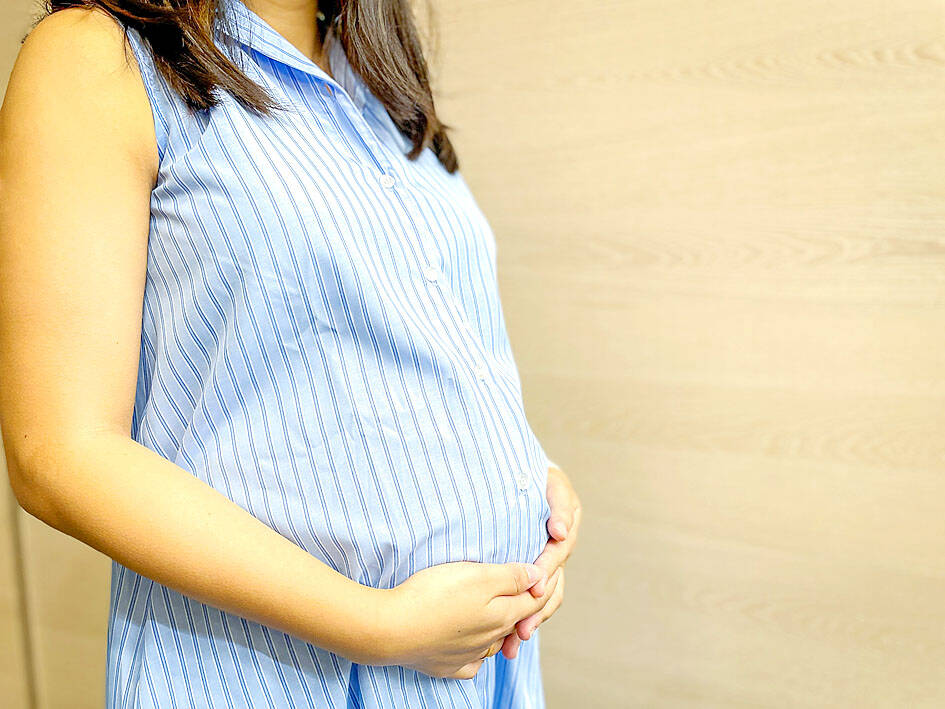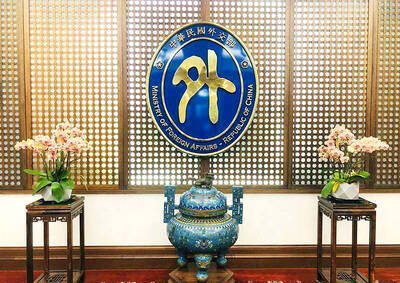The coverage rate of government-funded prenatal checkups reached 96 percent last year, the Health Promotion Administration (HPA) said on Tuesday, urging expectant mothers to ensure they receive four important examinations.
The number of government-funded prenatal checkups was expanded from 10 visits to 14 in July 2021, and last year up to 96 percent of expectant mothers received the checkups, the administration said.
The most common question the HPA receives about the government-funded prenatal checkups is what examinations are included, followed by how to apply for the checkup subsidy, it said.

Photo: CNA
About 70 percent of the inquiries were from expectant mothers, while about 20 percent were expectant fathers and about 10 percent were from other family members, it said.
The routine prenatal checkup items for all 14 visits include basic consultations about current health status, physical exams (weight, blood pressure, edema, varicose veins, fetal heartbeat, fetal position) and lab tests, such as urine and blood.
In addition to the routine checkup items, there are four important types of examinations that are included in the government-funded checkups, which are provided at specific weeks of pregnancy, the HPA said.
The four types of examinations include ultrasound scans to create images of the fetus for the expectant parents to see and for the doctor to monitor its growth, the administration said, adding that three scans are provided at between eight and 16 weeks, near the 20th week and after the 32nd week of pregnancy.
Another type of examination is for anemia, as about 10 to 20 percent of expectant mothers have the condition in the early stages of pregnancy. Pregnancy anemia might increase risks for the mother and the baby, such as preterm delivery, low birth weight and developmental problems in the infant.
The third type of examination is gestational diabetes screening, which is included in high-risk pregnancy situations, the HPA said.
Expectant mothers should receive a screening test between 24 and 28 weeks of pregnancy, and it can be administered at the same time as the anemia test, it said.
If expectant mothers have gestational diabetes, they can reduce their risk of developing complications by controlling their diet, exercising regularly and monitoring their blood sugar levels daily, it added.
The last type of examination is group B streptococcus (GBS) screening, which is a vaginal and rectal swab for detecting the presence of GBS bacteria, recommended between 35 and 37 weeks of pregnancy, it said.
The prevalence of GBS colonization in expectant mothers is nearly 20 percent, it said, adding that if an expectant mother tests positive for GBS, the doctor might assess whether a preventive antibiotic should be administered before giving birth.
Regarding how to apply for the checkups, the HPA said that when a woman is confirmed to be pregnant by a doctor, the hospital or clinic would give them the “Maternal Health Booklet.”
Expectant mothers only need to bring their booklet and their National Health Insurance (NHI) card to a NHI-contracted healthcare facility to get the checkups according to the recommended schedule, it said
The HPA also recommended that expectant mothers or family members check its dedicated Web site (https://mammy.hpa.gov.tw) for more information.

The German city of Hamburg on Oct. 14 named a bridge “Kaohsiung-Brucke” after the Taiwanese city of Kaohsiung. The footbridge, formerly known as F566, is to the east of the Speicherstadt, the world’s largest warehouse district, and connects the Dar-es-Salaam-Platz to the Brooktorpromenade near the Port of Hamburg on the Elbe River. Timo Fischer, a Free Democratic Party member of the Hamburg-Mitte District Assembly, in May last year proposed the name change with support from members of the Social Democratic Party and the Christian Democratic Union. Kaohsiung and Hamburg in 1999 inked a sister city agreement, but despite more than a quarter-century of

Taiwanese officials are courting podcasters and influencers aligned with US President Donald Trump as they grow more worried the US leader could undermine Taiwanese interests in talks with China, people familiar with the matter said. Trump has said Taiwan would likely be on the agenda when he is expected to meet Chinese President Xi Jinping (習近平) next week in a bid to resolve persistent trade tensions. China has asked the White House to officially declare it “opposes” Taiwanese independence, Bloomberg reported last month, a concession that would mark a major diplomatic win for Beijing. President William Lai (賴清德) and his top officials

The Ministry of Foreign Affairs (MOFA) yesterday expressed “grave concerns” after Singaporean Prime Minister Lawrence Wong (黃循財) reiterated the city-state’s opposition to “Taiwanese independence” during a meeting with Chinese Premier Li Qiang (李強). In Singapore on Saturday, Wong and Li discussed cross-strait developments, the Singaporean Ministry of Foreign Affairs said in a statement. “Prime Minister Wong reiterated that Singapore has a clear and consistent ‘one China’ policy and is opposed to Taiwan independence,” it said. MOFA responded that it is an objective fact and a common understanding shared by many that the Republic of China (ROC) is an independent, sovereign nation, with world-leading

‘ONE CHINA’: A statement that Berlin decides its own China policy did not seem to sit well with Beijing, which offered only one meeting with the German official German Minister for Foreign Affairs Johann Wadephul’s trip to China has been canceled, a spokesperson for his ministry said yesterday, amid rising tensions between the two nations, including over Taiwan. Wadephul had planned to address Chinese curbs on rare earths during his visit, but his comments about Berlin deciding on the “design” of its “one China” policy ahead of the trip appear to have rankled China. Asked about Wadephul’s comments, Chinese Ministry of Foreign Affairs spokesman Guo Jiakun (郭嘉昆) said the “one China principle” has “no room for any self-definition.” In the interview published on Thursday, Wadephul said he would urge China to